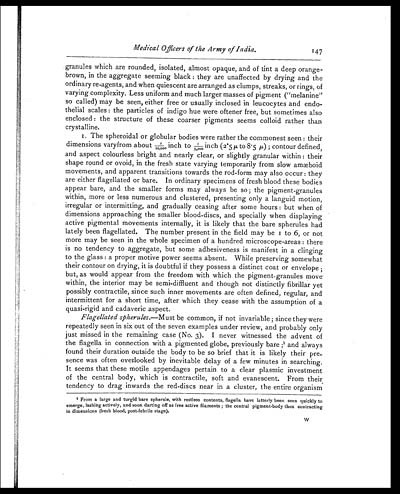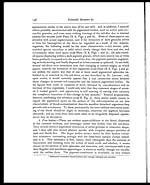Medicine - Institutions > Army health reports and medical documents > Scientific memoirs by medical officers of the Army of India > Part III, 1887 > 10 - Note on some aspects and relations of the blood-organisms in ague
(153) Page 147
Download files
Individual page:
Thumbnail gallery: Grid view | List view

Medical Officers of the Army of India.
147
granules which are rounded, isolated, almost opaque, and of tint a deep orange-
brown, in the aggregate seeming black: they are unaffected by drying and the
ordinary re-agents, and when quiescent are arranged as clumps, streaks, or rings, of
varying complexity. Less uniform and much larger masses of pigment ("melanine"
so called) may be seen, either free or usually inclosed in leucocytes and endo-
thelial scales: the particles of indigo hue were oftener free, but sometimes also
enclosed: the structure of these coarser pigments seems colloid rather than
crystalline.
1. The spheroidal or globular bodies were rather the commonest seen: their
dimensions varyfrom about1/10,000 inch to 1/3,000 inch (2.5 µ to 8.5 µ); contour defined,
and aspect colourless bright and nearly clear, or slightly granular within: their
shape round or ovoid, in the fresh state varying temporarily from slow amæboid
movements, and apparent transitions towards the rod-form may also occur: they
are either flagellated or bare. In ordinary specimens of fresh blood these bodies
appear bare, and the smaller forms may always be so; the pigment granules
within, more or less numerous and clustered, presenting only a languid motion,
irregular or intermitting, and gradually ceasing after some hours: but when of
dimensions approaching the smaller blood-discs, and specially when displaying
active pigmental movements internally, it is likely that the bare spherules had
lately been flagellated. The number present in the field may be 1 to 6, or not
more may be seen in the whole specimen of a hundred microscope-areas: there
is no tendency to aggregate, but some adhesiveness is manifest in a clinging
to the glass: a proper motive power seems absent. While preserving somewhat
their contour on drying, it is doubtful if they possess a distinct coat or envelope;
but, as would appear from the freedom with which the pigment-granules move
within, the interior may be semi-diffluent and though not distinctly fibrillar yet
possibly contractile, since such inner movements are often defined, regular, and
intermittent for a short time, after which they cease with the assumption of a
quasi-rigid and cadaveric aspect.
Flagellated spherules. —Must be common, if not invariable; since they were
repeatedly seen in six out of the seven examples under review, and probably only
just missed in the remaining case (No. 3). I never witnessed the advent of
the flagella in connection with a pigmented globe, previously bare;1and always
found their duration outside the body to be so brief that it is likely their pre-
sence was often overlooked by inevitable delay of a few minutes in searching.
It seems that these motile appendages pertain to a clear plasmic investment
of the central body, which is contractile, soft and evanescent. From their
tendency to drag inwards the red-discs near in a cluster, the entire organism
1From a large and turgid bare spherule, with restless contents, flagella have latterly been seen quickly to
emerge, lashing actively, and soon darting off as free active filaments; the central pigment-body then contracting
in dimensions (fresh blood, post-febrile stage).
w
Set display mode to: Large image | Zoom image | Transcription
Images and transcriptions on this page, including medium image downloads, may be used under the Creative Commons Attribution 4.0 International Licence unless otherwise stated. ![]()
| Permanent URL | https://digital.nls.uk/75004465 |
|---|
| Shelfmark | IP/QB.10 |
|---|---|
| Additional NLS resources: | |




